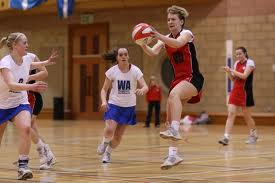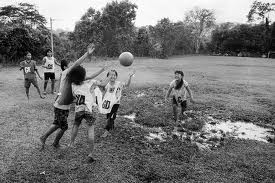Main Menu
Latest Blog Entry
User login
From the ground up: how to get fit for netball
The Physical Demands of Netball

Netball at speed
England have completed a series whitewash against World Champions Australia, England netball ‘s “Back to Netball” scheme is trying to get more women playing. but are they fit enough to play?
This article will look at the fitness requirements of netball, its various positions and then part 2 will look at how to get fit to play netball.
Netball is a classic example of a sport that expresses physical capabilities, rather than developing them. Lack of training prior to playing could lead to injury.
The Game
Netball is played by 7 players with up to 5 substitutes. Where a player can go on the court is determined by their position. The match is split into 4 quarters of 15 minutes, between quarters 1/2 & 3/4 there is a 3 minute break and half time is 5 minutes.
It requires short repeated bouts of mixed intensities to change direction, make evasive maneuvers and track players.
Physiological demands
During a game players will work intermittently in random patterns, which differ depending on position. You are allowed unlimited substitutions but these must only be made between quarters or if a player is injured. A study (1)was conducted looking at players movements, for the study shuffling is considered as sideways movements.
|
|
Centre |
Goal Keeper |
Goal Shooter |
|
Walk |
1877 (88) |
1839 (64) |
1706 (267) |
|
Jog |
1756 (305) |
195 (71) |
283 (160) |
|
Shuffle |
2025 (282) |
2037 (233) |
1430 (272) |
|
Run |
1758 (494) |
143 (37) |
362 (169) |
|
Sprint |
555 (274) |
69 (54) |
370 (233) |
|
Total |
7984 (767) |
4283 (261) |
4210 (477) |
Table refers to distance (m) travelled during a match at different speeds with the variance in brackets.
This shows that a centre can travel twice the distance of a goal keeper/shooter with jogging and running being the 2 areas of difference, this is due to the rules that limit the movement of different positions.
They then looked at the relative time spent at the different speeds:
|
|
Centre |
Goal Keeper |
Goal Shooter |
|
Standing |
12.3 (1.8) |
35.3 (2.8) |
44.8 (2.4) |
|
Walking |
31.8 (2.4) |
38.7 (0.7) |
31.1 (1.2) |
|
Jogging |
17.2 (2.5) |
1.7 (0.7) |
2.5 (0.9) |
|
Shuffle |
20.3 (2.8) |
23.3 (2.4) |
14.8 (2.2) |
|
Run |
14.7 (2.3) |
0.9 (0.3) |
2.0 (0.8) |
|
Sprint |
2.4 (1.2) |
0.3 (0.5) |
2.2 (0.9) |
Looking at relative times we can see that centres spend significantly less time standing, equal time walking and shuffling and a greater time at higher speeds.
Another aspect to look at is movement frequency, how many times each movement was done.
|
|
Centre |
Goal Keeper |
Goal Shooter |
|
Standing |
213 (53) |
226 (23) |
270 (33) |
|
Walking |
298 (13) |
236 (20) |
243 (36) |
|
Jogging |
251 (33) |
38 (13) |
52 (26) |
|
Shuffle |
253 (54) |
157 (18) |
179 (30) |
|
Run |
202 (34) |
25 (7) |
51 (20) |
|
Sprint |
49 (19) |
10 (6) |
43 (27) |
|
Total |
1266 (62) |
692 (40) |
838 (39) |
The last table shows that centres change their movement considerably more than the other positions.
What does this mean for training?
 We can start to see how different positions require a different emphasis in training.
We can start to see how different positions require a different emphasis in training.
The more static positions of goal keeper/shooter will require greater agility and explosiveness whereas centres will need a greater endurance as well as agility.
The rules of netball dictate that players must come to a stop one and a half steps after receiving the ball, this means that every player is required to brake suddenly from different speeds.
To be able to efficiently & effectively brake we need to have a level of physical competency. Kelvin Giles describes physical competency as:
“The ability of the body to ‘read’ all aspects of the physical environment, anticipating movement needs or possibilities and responding appropriately to these, with efficiency, intelligence and imagination.”
Part 2 of this article will look at how to develop this.
Duncan Buckmaster
Reference
1 Understanding the Physiological Demands of Netball: a time-motion investigation, Anna Davidson and Grant Trewartha, University of Bath
Client Testimonials
 Exeter Chiefs Rugby Academy
Exeter Chiefs Rugby Academy
James was in sole charge of fitness related matters, organising and implementing training programmes... also provided players with mentoring and advice on nutritional needs. He varied the programmes and was keen to keep ideas fresh and designed activities suitable to help young rugby player's progress. James was keen to put time into the thought process of his ideas and carry out to a very high standard.
More


Comments
[…] It is a game prone to ankle and knee injuries due to the sudden changes in direction, rapid acceleration and recurrent landings required (More detail here) […]
[…] From the ground up, how to get fit for Netball. Why returning to Netball needs to include fitness training. Netball fitness pt 2. Practical […]